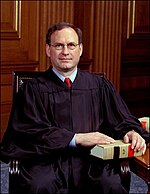
The Supreme Court of the United States (SCOTUS) is the highest court in the federal judiciary of the United States. It has ultimate appellate jurisdiction over all U.S. federal court cases, and over state court cases that turn on questions of U.S. constitutional or federal law. It also has original jurisdiction over a narrow range of cases, specifically "all Cases affecting Ambassadors, other public Ministers and Consuls, and those in which a State shall be Party." The court holds the power of judicial review: the ability to invalidate a statute for violating a provision of the Constitution. It is also able to strike down presidential directives for violating either the Constitution or statutory law.
This page serves as an index of lists of United States Supreme Court cases. The United States Supreme Court is the highest federal court of the United States.

Joseph McKenna was an American politician who served in all three branches of the U.S. federal government as a member of the U.S. House of Representatives, as U.S. Attorney General and as an Associate Justice of the Supreme Court. He is one of seventeen members of the House of Representatives who subsequently served on the Supreme Court.

Samuel Anthony Alito Jr. is an American jurist who serves as an associate justice of the Supreme Court of the United States. He was nominated to the high court by President George W. Bush on October 31, 2005, and has served on it since January 31, 2006. After Antonin Scalia, Alito is the second Italian American justice to serve on the U.S. Supreme Court.
In law, a per curiamdecision or opinion is one that is not authored by or attributed to a specific judge, but rather to the entire court or panel of judges who heard the case. The term per curiam is Latin for "by the court".

The Supreme Court of the United States is the highest court in the federal judiciary of the United States. The procedures of the Court are governed by the U.S. Constitution, various federal statutes, and its own internal rules. Since 1869, the Court has consisted of one chief justice and eight associate justices. Justices are nominated by the president, and with the advice and consent (confirmation) of the U.S. Senate, appointed to the Court by the president. Once appointed, justices have lifetime tenure unless they resign, retire, or are removed from office.

The Roberts Court is the time since 2005 during which the Supreme Court of the United States has been led by John Roberts as Chief Justice. Roberts succeeded William Rehnquist as Chief Justice after Rehnquist's death.

Robert Trimble was a lawyer and jurist who served as Justice of the Kentucky Court of Appeals, as United States district judge of the United States District Court for the District of Kentucky and as Associate Justice of the Supreme Court of the United States from 1826 to his death in 1828. During his brief Supreme Court tenure he authored several majority opinions, including the decision in Ogden v. Saunders, which was the only majority opinion that Chief Justice John Marshall ever dissented from during his 34 years on the Court.

The 2010 term of the Supreme Court of the United States began October 4, 2010, and concluded October 1, 2011. The table illustrates which opinion was filed by each justice in each case and which justices joined each opinion.

The 2017 term of the Supreme Court of the United States began October 2, 2017, and concluded September 30, 2018. The table below illustrates which opinion was filed by each justice in each case and which justices joined each opinion.

The 1999 term of the Supreme Court of the United States began October 4, 1999, and concluded October 1, 2000. The table illustrates which opinion was filed by each justice in each case and which justices joined each opinion.

The 2021 term of the Supreme Court of the United States began October 4, 2021, and concluded October 2, 2022. The table below illustrates which opinion was filed by each justice in each case and which justices joined each opinion.

The Supreme Court of the United States handed down eight per curiam opinions during its 2021 term, which began October 4, 2021 and concluded October 2, 2022.

The 2022 term of the Supreme Court of the United States began October 3, 2022, and concluded October 1, 2023. The table below illustrates which opinion was filed by each justice in each case and which justices joined each opinion.





